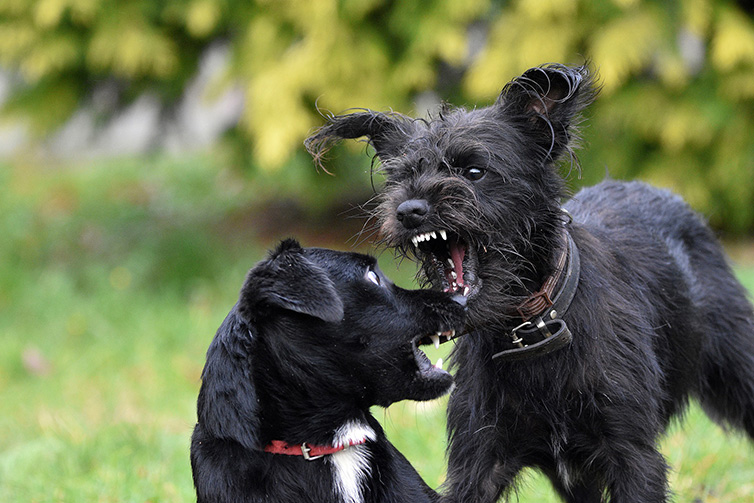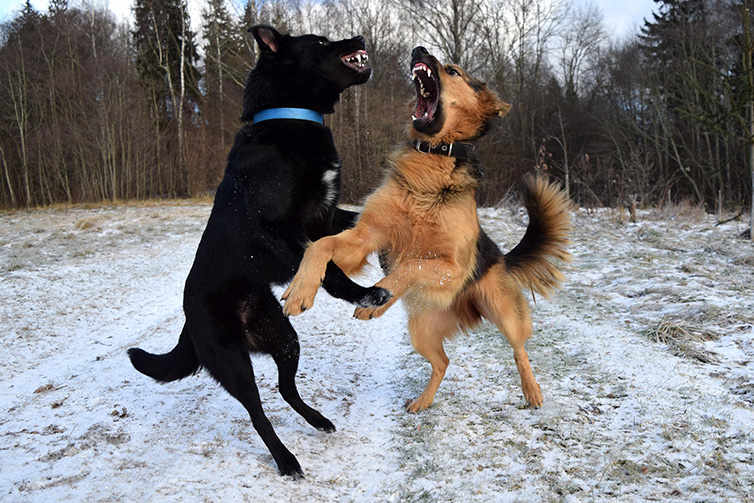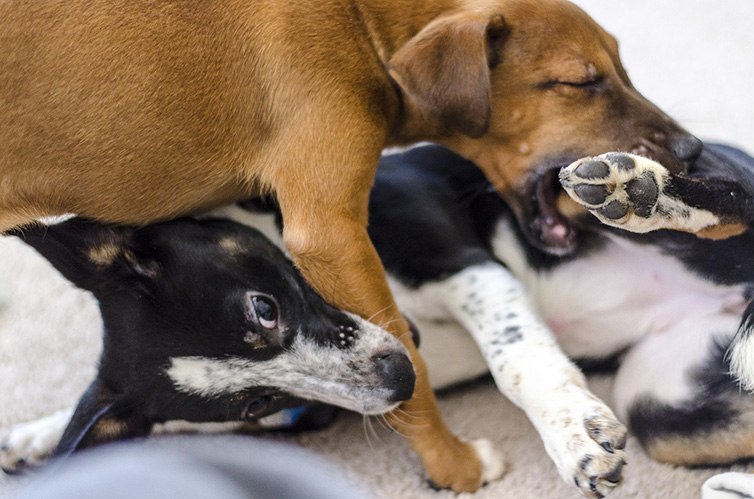Help! My dogs are fighting!

‘I was sitting in my lounge with my two female dogs, Lucy and Amy, outside. All of a sudden I heard the most dreadful noise and I ran outside: the two of them were in the most ferocious fight, spitting, snarling and growling, with fur and blood flying. I was so shocked and horrified – nothing like this had happened before. I ran to get the hosepipe, switched it on, full blast and sprayed it into their faces while I was screaming at the top of my voice. It made no difference. I got a garden chair and tried to ram in in between them. That didn’t work either. My neighbour arrived and we tried to drag them apart by pulling on their tails – I was actually afraid that we’d pull their tails off, but I knew at this stage that if they weren’t stopped, they’d fight to the death of at least one of them. My neighbour took hold of Lucy’s back legs and I grabbed Amy’s … eventually, they came apart, snarling, biting, ferocious and bleeding. My husband had arrived home by now, thank goodness and we took them, separately, to the vet, where they were cleaned up and stitched and Amy was put on a drip, but luckily their injuries looked a lot worse than they actually were. They were both in shock and so were my poor neighbour and I. I just couldn’t believe that my two placid and easygoing girls had, in seconds, become ferocious fighters, intent on killing each other.’
Some of you will, unfortunately, be able to relate to this story, based on an actual event, when normally friendly, placid dogs, who have lived happily together for years, will turn on each other for apparently no reason, and try to tear each other to pieces. Like humans, dogs are a social species, but just as we don’t always get along happily with each other, neither do dogs. But what makes two canine companions suddenly turn on each other, seemingly out-of-the-blue?
Why Dogs Fight
Generally, the main reason is stress. Dogs, and people, don’t usually lash out at each other for no reason. An easy-going mom may suddenly ‘lose her cool’ with her kids, but this rarely comes out of nowhere. You will usually find that she has had a dreadful day, when the washing machine broke down, the children became bored and naughty and she was trying to deal with a crying baby while the dinner burnt. Sometimes, as we know, it just takes one little thing, on top of all the other stressors, to tip a person over-the-edge, who then, either verbally or even physically, lashes out uncharacteristically.
It’s the same for dogs. Added stressors in their lives can sometimes push them over-the-edge too. For example, during the pandemic lockdown many of us will have noticed that our anger thresholds became lower as a result of being confined to our homes perhaps with bored children. Family stress like this can be felt by our dogs who may be pushed over their anger and fighting threshold.

Stressors for Dogs
Remember that just as with human beings, it’s rarely just one simple thing – like the other dog coming too close to his/her food – that triggers aggressive behaviour in an otherwise placid dog. There can be several possible stressors that you will need to identify in order to understand this often uncharacteristic behaviour:
- People passing the house or garden
- Phone or doorbell ringing
- Perceived threats to food or toys
- Trips to the vet or doggie parlour
- Thunder or fireworks
- Physical pain, such as a chronic condition like arthritis
- Shock collar
- Physical or verbal punishments
- Another dog, either familiar or unfamiliar
- Stress of owner
We may of course be aware of many of these, but in some cases, it may be difficult to do anything about them. Where possible, minimize your dog’s exposure to the stressor. For example, if passers-by trigger an aggressive response, try to close off your dog’s access to the fence or window. If thunder and lightning are stressors, minimize exposure by confining your dog to a small room, use a ‘thunder-blanket’ and ask your vet about anti-anxiety medication. Where possible, remove the stressor. For example, discard the shock collar and avoid punishing your dog for ‘bad’ behaviour. Punishment does not remove the behaviour; positive reinforcement of ‘good’ behaviour is the answer.
Animal behaviourists train dogs to change their opinion of certain stressors by using:
- Counter-conditioning, which involves changing the dog’s emotional response or attitude towards a stressor – for example, an aggressive or fearful response to a visitor
- Desensitisation, which is gradual exposure to a stressor, where the dog becomes less and less reactive
- Operant conditioning which teaches the dog, through rewarding him/her for desirable behaviour i.e. not over-reacting to a stressor
These strategies form part of a specialized training programme, run by professional animal behaviourists, but you can learn them and then implement the basic techniques yourself.
In the case of Lucy and Amy, above, this is what animal behaviourists call ‘social aggression’. It is not caused by the wish to dominate but is caused by neither dog wanting to defer to the other. ‘Dominance’ refers to which dog has access to something which both dogs want e.g. a bone.
Fighting vs Rough Play

Obviously, prevention of a dog fight is the best scenario. How can you tell the difference? Dogs often play to ‘rehearse’ real fighting behaviour. They may seem to be aggressive and appear to be biting. They may also growl and bark. To determine whether or not your dogs are fighting or playing, look at their body language:
- If the action begins with a ‘play-bow’ (where the dog’s front end goes down and the rear end stays up), then the dogs are playing.
- If their lips are tight and snarling, as opposed to being loose and open, then they are probably fighting.
- Are they tense and stiff or floppy and relaxed? Tense dogs are ready for a fight.
- Are their movements big and bouncy or fast and confined? Bouncy movements suggest play.
- If the dogs are taking turns at being the aggressor, then they are probably playing.
Signs of Stress
The other strategy to help prevent a dog fight is to look for signs of stress. If you can spot these, you may be able to defuse the potential fight by intervening and removing your dog from the situation. Signs of stress may include the following:
- Tail tucked under the body
- Ears flat against the head
- The whites of the eyes are visible
- Growling, barking or whining
- Yawning
- Licking lips
- Panting
- Pacing
- Excess sniffing
- Hard staring at the other dog
Additionally, aggression may be indicated by:
- Hard staring
- Hackles raised
- Sudden freezing
- A stiff or wagging tail
Breaking-Up a Dog Fight
You may have been very conscientious about dealing with possible stressors which may trigger a fight and you may have been vigilant about watching for signs of stress and aggression, but the fact is that one day you may be faced with a dog fight, whether between your own dogs or between your dog and a strange one. We know that this could result in being a matter of life or death for one or even both dogs, so it is important to know how to deal with this in order to avoid serious injury to either dog or to yourself.
- Avoid putting yourself or any other person, at risk. Never put yourself in between fighting dogs. It is pointless to shout at your dog – in a fight, he/she will be incapable of recognizing your voice or obeying your commands. You could get seriously injured. However, most of the following strategies will be easier if you can enlist someone else’s help.
- Try to distract the dogs. A loud noise like banging metal objects together might distract one of them long enough for you to pull him/her away.
- Another type of distraction is to spray them with a garden hose or to throw a bucket of water over them. Spraying with a vinegar spray, a lemon or citronella spray – smells dogs dislike – may also stop them for a couple of vital seconds.
- Throw a blanket over each dog. If they can no longer see each other, it may distract them from the fight.
- A large, strong object may be used to try to separate the dogs, such as a garden chair, a strong piece of wood or a metal dustbin lid. Be very careful to avoid putting any part of your body in the way. If possible, try to break the jaw grip of one of the dogs by sliding a stick horizontally close to the back of the dog’s throat, which will force them to release their grip.
- If you have two large laundry baskets you can try dropping one over each dog to separate them.
- As a last resort, you could try to separate the dogs physically. One way to do this, if you have someone to help you, is the ‘wheelbarrow technique’. Each person grabs one dog from behind by the legs, lifting their rear ends from the ground and pulling backwards to separate the dogs. Keep them far enough apart to avoid their resuming the fight.
- Keep the dogs far away from each other and ensure that they are tethered. Calm them down. A dog fight is very traumatic for the dogs, and for you.
- If you cannot break up the fight or if you feel you will risk serious injury if you attempt to do so, then your only option is to stay out of it. Dogs do suffer serious injuries and even get killed in a dog fight, but you must not compromise your own safety.
- Take both dogs, separately, to a vet to assess and treat their injuries.
- If you have been bitten or injured, you will need to go to your doctor or an emergency room for treatment.
Remember that there is no substitute for a qualified animal behaviourist if you feel you cannot cope, especially if you feel that you are dealing with an aggressive dog.
SOURCES
www.while-dog-journal.com
www.ack.org
www.ccspca.com
ZA-BRV-220300008

Subscribe to our Newsletter
Get to know your furry friend better! Sign up for all things dog- or cat-related.
The Hairy Facts about the dreaded hairball
12 April 2021
Help! My dog’s barking mad! Volume 2
12 April 2021
Your Itchy, Scratchy Cat – All About Cat Skin Problems
12 April 2021
The Dog’s Diet: A Bone of contention?
01 April 2021
Mango Fly Worms: How to Spot and Eliminate them
Posted on November 28,2019
Managing Mange And Mites In Your Dog
Posted on June 11,2018
Why Do Cats Purr and How? Learn What Your Cat Is Saying
Posted on October 14,2020
How to Get Rid of Ear Mites in Dogs
Posted on November 06,2019









